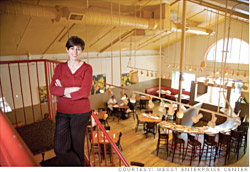
NOVEMBER 2011
Q&A with David M. Gipp, President, United Tribes Technical College (UTTC)UTTC is a partner in the Upper Missouri Tribal Environmental Risk Mitigation project that recently received a $1.7 million award as part of the Obama Administration's $37 million Jobs and Innovation Accelerator Challenge, a multi-agency competition to support the advancement of 20 high-growth, regional industry clusters. 
David M. GippDavid M. Gipp is president of United Tribes Technical College, an intertribal, post-secondary vocational technical college for American Indian students and their families in Bismarck, ND. Born at Fort Yates, ND, Gipp is an enrolled member of the Standing Rock Sioux Tribe. His Hunkpapa Lakota name, Wicahpi Isnala, translates as Lone Star. Q. The Upper Missouri Tribal Environmental Risk Mitigation project received a $1.7 million Jobs and Innovation Accelerator Challenge award to support a network to accelerate jobs and business development in natural resources and reduce unemployment in economically distressed tribal areas of the upper Missouri River basin. How will the United Tribes Technical College accomplish this? A:There are three distinct activities that work toward accelerating jobs and business development in environment risk mitigation. The first is to train people in the field of environmental risk mitigation using a career ladder approach. This will allow project participants to meet and build upon short term goals and advance as far as a Bachelors degree. The second strategy involves a particular group of tribal workers: tribal planners. This is an existing network that is key to reservation development. Tribal planners are responsible for building and sustaining economically healthy communities. The UM-TERM Project focuses on strengthening the understanding of tribal planners in the field of environmental risk mitigation. In turn, they can promote the conditions for growth in that field and help plan for mitigation projects in and around their communities. The third strategy is to leverage Small Business Administration support that exists in the region. To this support will be added Native American-specific resources, such as the Indianpreurship Program, designed to help build businesses and succeed in tribal communities. Tribal communities in the region are characterized by high unemployment and low socio-economic conditions. They also have unique, cultural value systems that differ from the mainstream. High value is placed on families and relationships, Mother Earth and spiritual well being. These are important values that figure strongly in the definition of success and often differ from what is considered wealth in the mainstream. Q. The project is designed to meet the region's need for qualified environmental technicians with the expertise to enable tribal entities to protect water rights, manage water and land resources, including mineral deposits and wildlife, and mitigate environmental risk. What is the current economic environment and what steps will be taken to turn it around? A: The reservations and target areas served by the project are places where the norm is economic depression and generational unemployment. In some cases unemployment rates approach 90 percent. This project focuses on training people in the field of environmental risk mitigation, which plays an important role in achieving tribal self-determination and independent management of tribal resources. The project brings together local, private, federal, and state entities to help create the business and job opportunities. Q. How is this partnership with federal agencies strengthening your efforts and what will the benefit be to Native American communities as federal, state, local, and tribal governmental agencies, and private businesses representing environmental fields connect and collaborate? A: This project brings together the two most important aspects of business building and job creation: networking and education. It is rare that the two get to happen in one project, and by integrating the services of the collaborating entities it is anticipated that this holistic approach will be successful. Spotlight: Jobs and Innovation Accelerator Challenge
Q: In developing the Jobs and Innovation Accelerator Challenge, a key focus was to make federal funding more accessible by reducing the burden on applicants (e.g., allowing a single narrative capped at 50 pages to apply for EDA, ETA, and SBA funding). Is this something you found helpful? Carl Meyer, President/CEO, The Solar Energy Consortium: Yes, the single narrative was very helpful. It allowed us to build consensus on what we were proposing. And it certainly saved some time. Judy Osburn, Grants Director, SUNY Orange: After we got a better handle on the instructions, yes, it was very helpful. Enrique Rob Lunski, President, Gateway To Entrepreneurial Q: What were the opportunities and challenges you encountered in designing your proposal, coordinating with your partners, and applying? Meyer: In designing our proposal, it quickly became clear that EDA needed us to marry our ongoing cluster work to one of the poorest communities in New York State. That was the challenge and it was daunting, to say the least, but we heard you loud and clear. The opportunities are substantial: we chose a city with a rich manufacturing history and a good base of motivated workers. As far as coordination with partners, that's what TSEC is all about so the grant played to our strength. We were able to mobilize fairly quickly. We are excited about our plan and can't wait to get started. Lunski: For GET, the biggest opportunity was becoming more educated on the services that each of the other partners provide while integrating our own specific missions into one comprehensive plan of action. Q: Do you believe coordinated federal funding, such as the Jobs Accelerator, is an effective tool to encourage regional collaboration and accelerate job creation? Meyer: Yes. Pooling funds from three agencies produced a sizable opportunity that got our attention, and it motivated us to put our best work forward. Lunski: Yes, the concept of reaching out to several funding agencies with one proposal seems to work well. At the same time it encourages collaborations among various service providers so that more individuals can served. This grant falls along the mission that GET has to help minorities and low income people start their own businesses in the underserved urban communities across the Mid-Hudson Valley region of New York State. By focusing its work in the City of Newburgh - with one of the highest rates of unemployment and poverty in the Nation - the Jobs and Innovation Accelerator Challenge grant will help boost the city’s economy from the ground up by providing employment opportunities in the renewable energy sector to a population that needs help the most. GET looks forward to working together with TSEC, SUNY Orange and the City of Newburgh to advance the creation of jobs and new enterprises in the city. This could well be a model that other underserved urban areas can adopt to provide for the economic growth of their people and bring in new businesses. Hot Topic
EDA Grantee WESST Recognized as One of Seven
|

October 20, 2011- Deputy Assistant Secretary Erskine delivers remarks at the dedication ceremony for the Ben Franklin TechVentures business incubator in Bethlehem, Pennsylvania |
Ben Franklin TechVentures® (BFTV), owned and operated by BFTP, has graduated 48 successful early-stage technology companies that together gross more than $408 million in annual revenue and have created 4,500 jobs. Twenty-six early-stage firms, employing 146 people, are currently located in Ben Franklin TechVentures. Ben Franklin TechVentures2, the essential 47,000-square-foot expansion of the original building that will open in Autumn 2011, will advance BFTP's ability to provide early-stage companies with reduced operating costs, business assistance, and the synergy of a business incubator. The new facility will allow BFTP to accommodate technology-based start-up companies that create as many as 200 jobs and retain 100 more in the first three years.
EDA-Grantee Ben Franklin TechVentures Named to Inc. Websites Top-10 List, Click here to learn more
|
|
||||
In This Issue
November is Native American Heritage MonthThe indigenous peoples of North America -- the First Americans -- have woven rich and diverse threads into the tapestry of our Nation's heritage. Throughout their long history on this great land, they have faced moments of profound triumph and tragedy alike. During National Native American Heritage Month, we recognize their many accomplishments, contributions, and sacrifices, and we pay tribute to their participation in all aspects of American society. - President Obama White House Native American Webpage 
President Obama Announces 2011 White House Tribal Nations ConferenceFriday, December 2, 2011Department of the Interior's Sidney R. Yates AuditoriumEach federally recognized tribe is invited to designate one representative to attend the Conference, as well as the briefing and listening session to be held at the White House. Please RSVP with the full name (including full middle name), position, tribe, social security number, date of birth, country of citizenship, country of birth, gender, current city and state of residence, e-mail and telephone number of your tribe's representative to [email protected] or fax a letter to (202) 456-1647, attention Tribal Nations Conference, by 10 p.m. EST on Wednesday, November 16, 2011. Economic ToolsTechnology and the Innovation Economy: How To Harness New Engines for GrowthTechnology is a great enabler of innovation. In areas from education and health care to entrepreneurship and science, technology promotes jobs, builds wealth, and benefits individuals, communities and societies. Technology has been a key driver of economic growth over the last two decades, fueling the innovation and entrepreneurship that are crucial to long-term economic development and prosperity. Access Report on Technology and the Innovation Economy The National Business Incubation Association (NBIA) provides thousands of professionals with the information, education, advocacy and networking resources to bring excellence to the process of assisting early-stage companies. The National Business Incubation Association in collaboration with the Appalachian Regional Commission and Tennessee Valley Authority created a peer-to-peer evaluation program for business incubation programs. DOC & DOT Announce Partnership to Boost Domestic Manufacturing Across AmericaOn October 18, 2011 Acting U.S. Commerce Secretary Rebecca Blank and U.S. Transportation Secretary Ray LaHood announced a partnership to encourage the creation of domestic manufacturing jobs and opportunities for U.S. suppliers through transportation investments. NEW EDA-FUNDED REPORT Agriculture Secretary Tom Vilsack and U.S. Trade Representative Ron Kirk announce the appointment of 148 private-sector members to the Agricultural Policy Advisory Committee and six Agricultural Technical Advisory Committees.

Upcoming EventsNovember 2, 2011 November 3, 2011 November 8, 2011 November 9, 2011 November 30 - December 2, 2011 
Extra ExtraIf you want to see how American communities can reinvent themselves to compete in today's global economy, just walk through downtown Pittsburgh. Once abandoned steel plants now house a thriving cluster of innovative robotics companies. Read editorial by U.S. Assistant Secretary Fernandez. U.S. EDA investments promote innovation and help create jobs Read editorial by U.S. Assistant Secretary Fernandez The Obama administration is collaborating with the private sector in an unprecedented way to promote American innovation, ignite entrepreneurship, and spur small business development to get the economy moving and put people back to work. Read blog post by U.S. Assistant Secretary Fernandez Deputy Assistant Secretary Erskine Pushes Obama Jobs bill at Chamber |


 Discussing Process With Jobs and Innovation Accelerator Challenge Winner New York Renewable Energy Cluster (NYREC): Carl Meyer, President/CEO, The Solar Energy Consortium; Judy Osburn, Grants Director , Orange County Community College (SUNY Orange); Enrique Rob Lunski, President, Gateway to Entrepreneurial Tomorrows, Inc.
Discussing Process With Jobs and Innovation Accelerator Challenge Winner New York Renewable Energy Cluster (NYREC): Carl Meyer, President/CEO, The Solar Energy Consortium; Judy Osburn, Grants Director , Orange County Community College (SUNY Orange); Enrique Rob Lunski, President, Gateway to Entrepreneurial Tomorrows, Inc.

